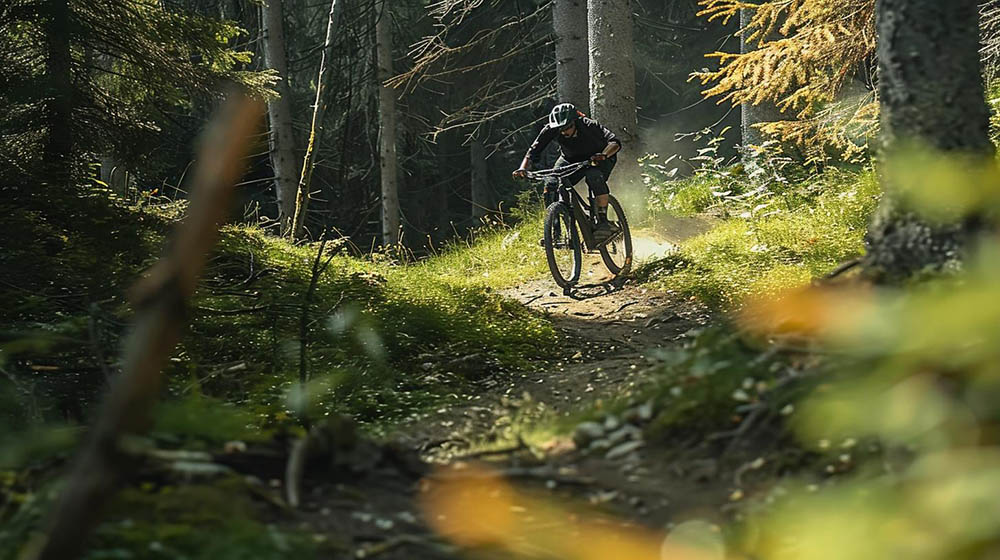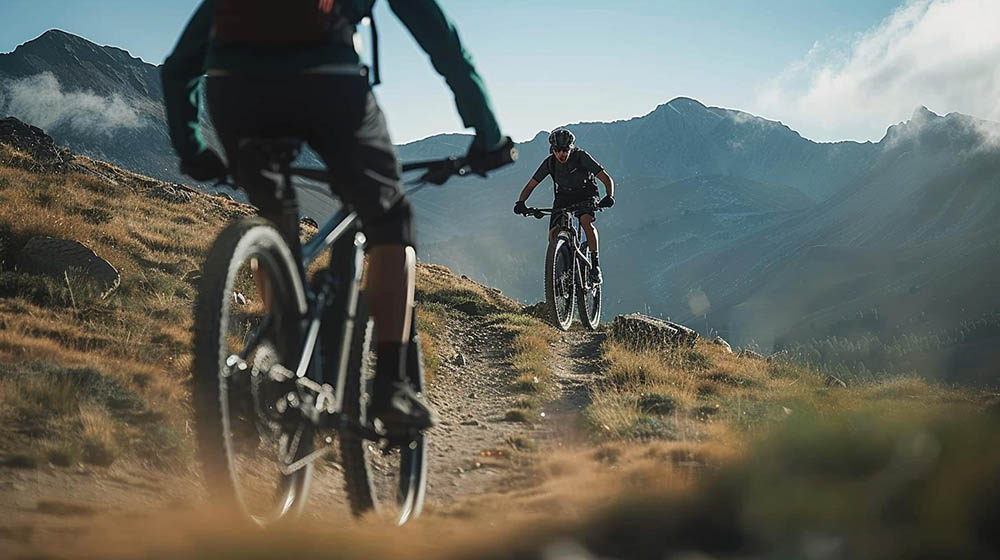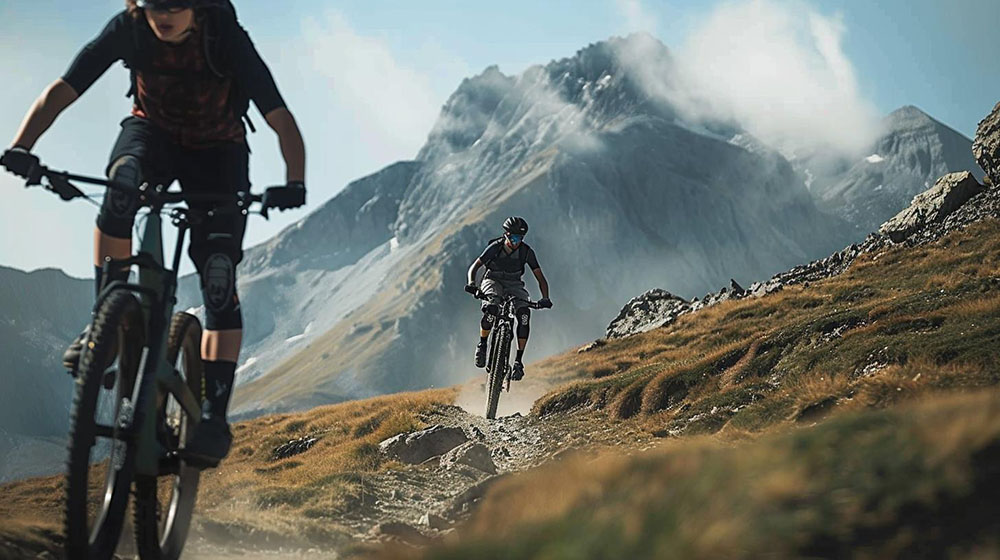Lightweight or full-fat, which MTB Ebike should you buy in 2024?
Every year, MTB ebike manufacturers keep trying to outdo each other, all vying for the coveted ‘lightest e-bike ever’ position – but what does this really mean for the rider, and is there a clear right and wrong answer? Is it really worth spending thousands of pounds more to lighten a bike by a few hundred grams?
We’ll break down a few example bikes to see why there’s such a big weight difference, and highlight the key differences between the pros and cons of each bike.
Why are some electric mountain bikes so heavy?
Excluding the motor, battery, controller and associated wiring, an electric mountain bike is really no different to a regular analog mountain bike. It has a frame, wheels, suspension, brakes, gears, and all the other interconnected parts you’d expect, but for all intents and purposes, it’s your current mountain bike.
There are other little things that add weight to an electric mountain bike. For example, there are eMTB-specific or “approved” suspension components and wheels that are built stronger to handle the additional stress of eMTB weight and strain. Similarly, even the carbon fiber frames on e-bikes are slightly thicker to handle the extra torque applied through them.
 The truth is, you can’t hide the weight of an e-bike, but in the last two years they’ve reached the weight of a non-electric bike from 10 years ago!
The truth is, you can’t hide the weight of an e-bike, but in the last two years they’ve reached the weight of a non-electric bike from 10 years ago!
Power and weight
I find myself saying this to customers almost daily in our showroom –
You can’t have all the power and all the range and no weight.
There is a cost between them, so as you might expect, the more power a bike produces, the heavier its motor is likely to be. The longer the theoretical range, the bigger the battery. The bigger the battery …… You guessed it.
Bikes with the largest motors and batteries are usually the heaviest. Of course, there are “lighter” options, but in general, any vehicle with a Bosch or Yamaha motor is likely to be over 22 kilograms.
When considering your first or next electric mountain bike, battery capacity and size will have a direct impact on the overall weight, ride feel and performance of the bike, and should be a primary consideration when choosing your next off-road machine.
Are lightweight electric mountain bikes underpowered?
“Underpowered” is a word I often hear from people who have never ridden an e-bike before, or who have been told by a Bosch Gen 4 or similar rider that “85Nm is the minimum you want”. Unfortunately, neither of these is true, but it does sometimes lead to bad buying decisions.
Going back to the power vs. weight debate, the heavier the bike, the more power it needs to overcome its weight, and the more power it produces, the more battery it needs to provide a reasonable range. Ultimately, swing the scales in all directions and you will reach a balance where the two are perfectly balanced.
In fact, no bike can be considered “underpowered”. They have the power they should have for the type of rider their designers had in mind. If you find a bike “underpowered”, it’s likely that you’re not the type of rider its designer had in mind, and that’s absolutely fine.
Lighter bikes cost more, almost exclusively for one reason: research and development.
The additional research and development costs of reducing the weight of a bike and its components often run into the millions of dollars for individual manufacturers. On top of that, every major advance in design and technology usually requires entirely new manufacturing techniques and tools, and entirely new manufacturing techniques and tools cost more. Carbon fiber frames also cost more to manufacture than alloy frames.
But is it all really worth it?
This is where things get a bit murky and it really depends on the individual.

In the simplest terms, even if you had all the money in the world, would it be worth spending £10,000+ on an electric mountain bike if you were literally just starting out? Absolutely not. You won’t be able to get anywhere near the performance limits of the bike for about 5 to 10 years.
On the other hand, if you’re already at a professional level and just want something to get you to the top quickly so you can do more downhill running, is it worth spending £3,000 on an entry-level electric mountain bike? The answer is the same. You’ll get to the top faster, but will be severely limited by its components on the way back.
The best way to choose
It’s worth checking out the bike’s specification (we provide a component level breakdown near the bottom of every product page) and making an honest assessment of your riding skills.
Don’t make the mistake of going straight for the cheapest option. It’s a poor buying decision in the long run, and you may find yourself as a skilled bike rider on a bike whose specs don’t match your skills, or as a new rider who has put in a year of solid skill work on a bike that no longer performs at your level.
Take the time to carefully consider the specifications of each model option. For the best long-term value, you’re looking at an option that offers more specs than you need right now , to ensure you have room to grow as a rider.
Again, don’t fall into the trap of needing to have the most stylish bike for the road. Let’s be honest, more expensive/lighter bikes don’t make better riders. No one is going to be impressed with a 15 kilogram e-bike with a Kashima coating on all the parts, a gorgeous paint job, and all-electric gears that spends more time circling trees than sitting on the seat!
How do you know if you need a “full fat” or light electric mountain bike?
Sometimes it’s a “need”, sometimes it’s a “want”, and almost always there is no 100% clear answer.
In my experience selling thousands of electric mountain bikes to all types of riders, I’ve found that it tends to vary in grade depending on whether the rider is buying their first bike or replacing an existing one, and their current experience and health.
Budget aside, this actually helps me categorize riders in three ways:
“power hungry.”
Those who want to do as little work as possible or want to buy their first bike are often influenced by the people they have ridden with or plan to ride with, or are very much caught up in the “I want all the power and motivation” mindset. All the range” mode. Sadly, if they are not adequately “guided” and properly educated about the pros and cons, this often leads to poor buying choices and rider experiences.
“Former Racers”
These are people who are already very accomplished riders and/or understand mountain bike performance (not necessarily ex-racers, but at least skilled), geometry, kinematics, and component complexity. They often take a more considered approach, and this deeper knowledge often naturally leads them to lighter weight bikes and/or often “healthier” riders, and to better buying decisions without being taught how to suck eggs. So this group also includes modified tourers or people who switch between the two.
“Second timer.”
A second (or more) timer will usually be outgrowing their current eMTB in one way or another.Often, this may be because they didn’t factor into their first bike’s specs that it was time to improve their skills as their mileage increased, now that they have an engine underneath them, and previously made a poor buying choice due to a lack of motivation eMTB education or information previously provided about them, or They just felt it was time to upgrade and by already owning a bike they at least know how a “fat vs. lean” eMTB feels.
What else should I consider when choosing between a full-fat EMTB or a lightweight EMTB?
The complexities of ownership are often overlooked, so here are some other things to consider, mostly as “side notes” to buying a new electric mountain bike in 2024;
Transportation
E-bikes, even lightweight ones, need special consideration when it comes to transportation if you find yourself needing to transport the bike to get it to where you want to ride it for repairs. Thankfully, at 6 feet 3 inches tall and weighing just 100 kilograms, it’s not that tricky to fit an e-bike into the trunk of my station wagon without a front wheel, but it can be a bit of a hassle for those who are shorter in stature or not very physically strong, or who may need extra hands at each end of the journey. Lighter bikes make this easier. Sometimes I struggle to cram nearly 30 kilograms of ebike into people’s boots when they’re able to do it themselves without repairs.
Traditional bike racks, such as those that clip onto the edge of a car panel, can only accommodate a “full-fat” ebike. Even the 3-bike version of Bones isn’t rated high enough to hold two, and it can damage the edge of your panel, or worse, drop them where you don’t want them. Speed. Might hit the bumper of someone unfortunate enough to be behind you.
Roof racks are usually rated high enough. The maximum permissible weight of most car roof racks is around 100 kilograms, sometimes even more. The trouble is always getting them up and down. For many people, lifting a 16.5 kg Orbea Rise over their heads is not too much trouble, but lifting a 30 kg FLYON and maneuvering it into the right slot before tying it down is more difficult than it sounds. Doable, but not ideal.

The best solution for carrying an electric mountain bike (if you’re lucky enough to be able to carry more than one, of course) is a towbar-mounted pannier rack. These usually hold a maximum of two and have a maximum capacity of around 60 kilograms. Their only disadvantage is that if you don’t already have a towbar fitted, it will cost up to around £1,000 to buy a towbar and a pannier rack just for carrying the bikes.
Trail obstacles
When off-roading I mainly ride ‘off-road’ and look for fast, flowing tracks and trails without too many big mandatory jumps, so maybe I encountered these more than most, but ultimately they catch up with almost all riders. Gates, cross turnstiles, fences and other things used to restrict animals or people from entering or leaving a place.
We recently had a customer who purchased his first bike online without chatting with us about it, and a few weeks later he came back to us for a trade-in. He had recently joined a new cycling group in the Sussex countryside in his West Country, but hadn’t “surrounded” himself with these routes and didn’t realize that he’d need to hold the bike over his head at approximately 1.5 mile intervals on a 30 mile ride. It was something he hadn’t considered, and at almost 70 years old, he simply couldn’t do it.
Sometimes, if you only ride locally, these types of obstacles can interfere with the process of owning a bike, but there are ways and practices that can help.
Maintenance and Manual Handling
If you like to do your own maintenance and fine-tuning, then having a workshop stand in your garage is almost a must.
In our workshop we have very snazzy electric bike stands that can lift bikes to any height or direction for our technicians to use, and sometimes in a single workday they may have as many as 20 different bikes on the stand, but at home you’re more likely to have a regular manual stand, and you’ll need to be able to lift your bike about 3 feet off the ground and have one hand free. so you can clamp it down with your other hand.
So, which one will you choose in 2024?
Ultimately, what you’re after should depend on what’s most important to you as a rider, but things aren’t always that simple. As a ground rule.
Those who are less fit, new to cycling or returning to cycling, struggling with injuries (knees, hips, etc.) or disabilities or otherwise needing as much support as possible should consider ‘full fat’ or around 80Nm power output.
Those who are already riders with a good to excellent level of basic fitness, those who are looking for an electric mountain bike to improve their fitness rather than relying solely on the motor to get them around, those who are focused solely on electric mountain bikes and want to skip the upgrade queue or those who just want to ‘feel’ and ride like a normal bike should definitely take advantage of the increased power outputs available in 2024. should definitely take advantage of lighter bikes in 2024.
We hope this has provided you with all the information you need to make a more informed buying decision on a full-fat or lightweight e-bike this year, but if you’re still struggling, feel free to reach out to us or make an appointment to come visit us, and we’d be happy to help you find a bike that suits your skills, fitness level, and your own riding style.
Have any questions? Drop us a line below! Let our well-designed MTB Electric Bike and quality outdoor accessories take you on a journey to explore nature and unleash your passion for unlimited adventure!
 Shuangye ebike
Shuangye ebike
